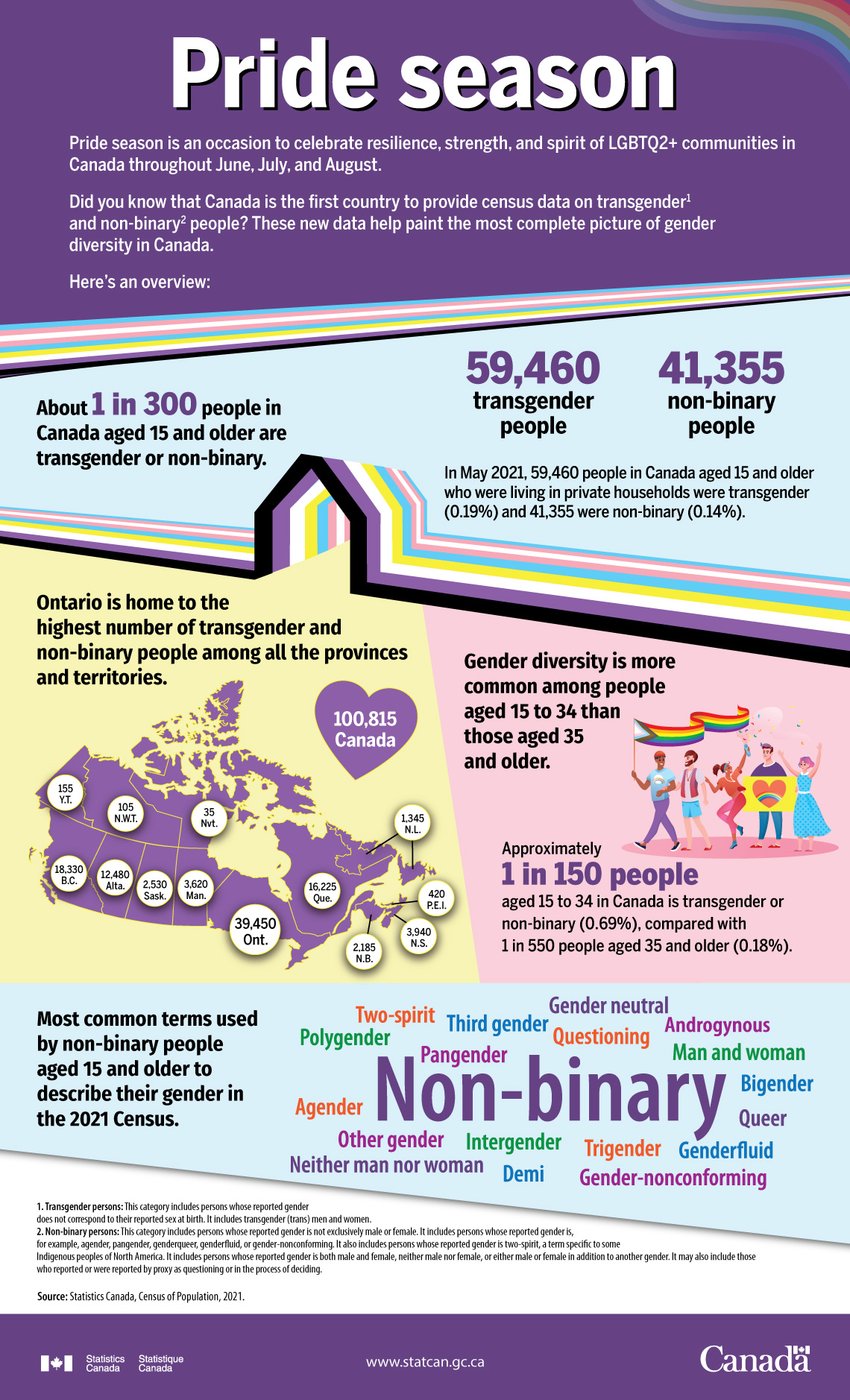Pride Season 2022... by the numbers
 Pride Season 2022... by the numbers (PDF, 2.27 MB)
Pride Season 2022... by the numbers (PDF, 2.27 MB)

Description: By the numbers - Pride Season 2022
Pride season is an occasion to celebrate the resilience, strength and spirit of LGBTQ2+ communities in Canada throughout June, July and August.
Did you know that Canada is the first country to provide census data on transgender and non-binary people? These new data help paint the most complete picture of gender diversity in Canada. Here's an overview:
About 1 in 300 people in Canada aged 15 and older are transgender or non-binary.
In May 2021, 59,460 people in Canada aged 15 and older who were living in private households were transgender (0.19%) and 41,355 were non-binary (0.14%).
Ontario is home to the highest number of transgender and non-binary people among all the provinces and territories.
- The number of transgender and non-binary people in Newfoundland and Labrador was 1,345.
- The number of transgender and non-binary people in Prince Edward Island was 420.
- The number of transgender and non-binary people in Nova Scotia was 3,940.
- The number of transgender and non-binary people in New Brunswick was 2,185.
- The number of transgender and non-binary people in Quebec was 16,225.
- The number of transgender and non-binary people in Ontario was 39,450.
- The number of transgender and non-binary people in Manitoba was 3,620.
- The number of transgender and non-binary people in Saskatchewan was 2,530.
- The number of transgender and non-binary people in Alberta was 12,480.
- The number of transgender and non-binary people in British Columbia was 18,330.
- The number of transgender and non-binary people in Yukon was 155.
- The number of transgender and non-binary people in Northwest Territories was 105.
- The number of transgender and non-binary people in Nunavut was 35.
- The number of transgender and non-binary people in Canada was 100,815.
Source(s): Census of Population, 2021 (3901).
Gender diversity is more common among people aged 15 to 34 than those aged 35 and older.
Approximately 1 in 150 people aged 15 to 34 in Canada is transgender or non-binary (0.69%), compared with 1 in 550 people aged 35 and older (0.18%).
Most common terms used by non-binary people aged 15 and older to describe their gender in the 2021 Census.
- non-binary
- agender
- androgynous
- bigender
- demi
- genderfluid
- gender neutral
- gender-nonconforming
- intergender
- man and woman
- neither man nor woman
- other gender
- pangender
- polygender
- queer
- questioning
- third gender
- trigender
- Two-Spirit
Source: Statistics Canada, Census of Population, 2021.
Definitions
Transgender persons: This category includes persons whose reported gender does not correspond to their reported sex at birth. It includes transgender (trans) men and women.
Non-binary persons: This category includes persons whose reported gender is not exclusively male or female. It includes persons whose reported gender is, for example, agender, pangender, genderqueer, genderfluid, or gender-nonconforming. It also includes persons whose reported gender is two-spirit, a term specific to some Indigenous peoples of North America. The category also includes persons whose reported gender is both male and female, neither male nor female, or either male or female in addition to another gender. It may also include those who reported or were reported by proxy as questioning or in the process of deciding.
- Date modified: